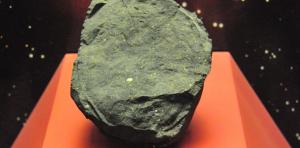Blog
It Came From Outer Space
7 April 2015
 National Museum of Natural History (Washington)
National Museum of Natural History (Washington)One of the big unsolved questions in chemistry and biology concerns the origin of life on Earth. One of the more speculative ideas on the matter is known as panspermia, or idea that life arose elsewhere and was seeded (either intentionally or through comets or meteors) on Earth. Thus, we came from outer space. It’s an idea that has been approached with both serious research and wild “ancient aliens” pseudoscience, so it doesn’t always get much respect in the field of astronomy.
Despite the occasional claims, such as the red rain incident that was claimed to contain extraterrestrial organisms,1 or the application of Moore’s law to the complexity of organisms to argue that life is older than Earth,2 there is no solid evidence that extraterrestrial organisms seeded life on Earth. And although abiogenesis is an unsolved problem, there is no indication that life couldn’t have originated on Earth.
That said, we also know that the building blocks of life, such as amino acids, sugars and fatty acids, have formed in space, and could have been brought to Earth. Perhaps the most famous example comes from a meteorite that fell near Murchison, Victoria, in Australia. Commonly known as the Murchison meteorite, it was observed to fall in 1969, and its fragments total more than 100 kilograms. It is a carbonaceous chondrite meteorite, which means it formed in the early solar system when dust grains began coalescing into small asteroids, and was never heated to its melting point.
Because samples were gathered soon after impact, the amount of possible contamination from terrestrial organics is minimal, so we can be confident that building block materials aren’t due to contamination. We’ve also found, for example that the sugars and amino acids from the asteroid are a mix of left and right handed molecules. Terrestrial organisms mainly use left-handed proteins (of which amino acids are the building blocks) and right-handed sugars. This would imply that the Murchison organics have a non-biological origin.3
By 2010, more than 70 amino acids and 14,000 other molecular compounds have been detected in the meteorite. We also now know that complex molecules can form in interstellar clouds, and these molecules could have survived through the formation of the solar system. So while life probably didn’t begin “out there,” it’s possible that organic material brought to Earth by meteors similar to Murchison could have helped jump start the rise of life by providing useful raw materials.
Louis, Godfrey, and A. Santhosh Kumar. “The red rain phenomenon of Kerala and its possible extraterrestrial origin.” Astrophysics and Space Science 302.1 (2006): 175-187. ↩︎
Sharov, Alexei A., and Richard Gordon. “Life before earth.” arXiv preprint arXiv:1304.3381 (2013). ↩︎
Kvenvolden, Keith, et al. “Evidence for extraterrestrial amino-acids and hydrocarbons in the Murchison meteorite.” Nature 228.5275 (1970): 923-926. ↩︎